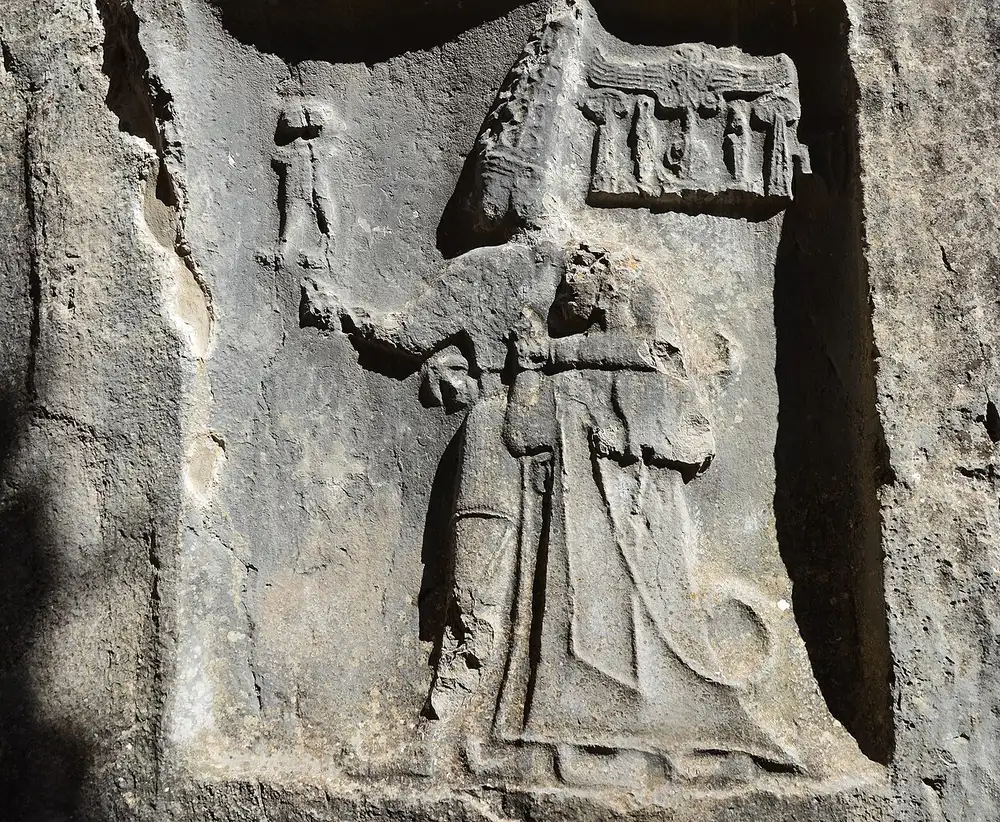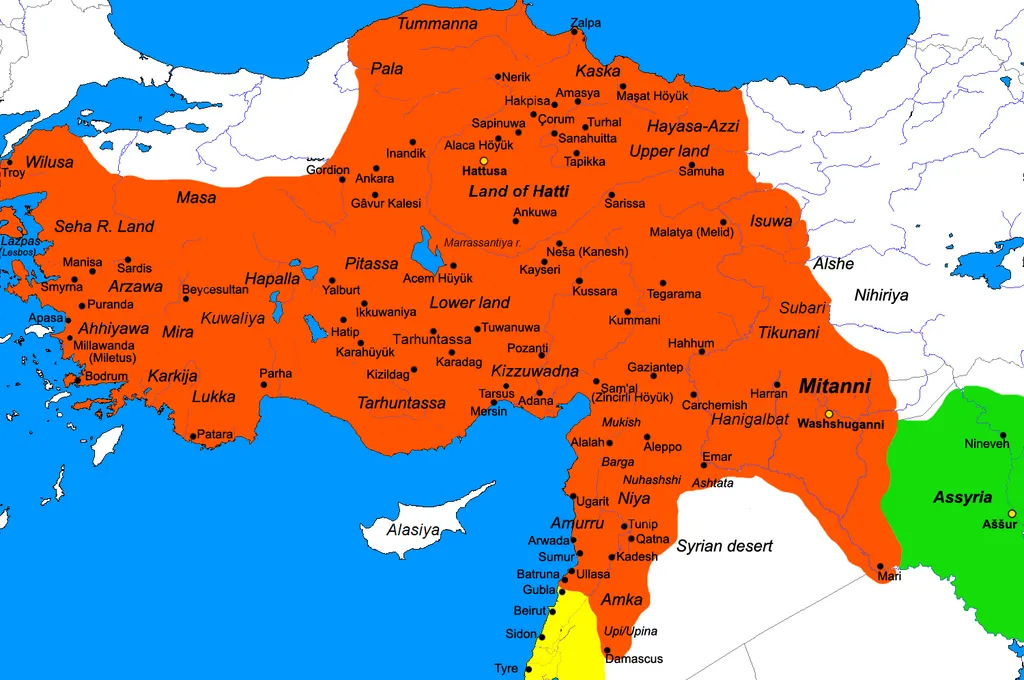
(Hattuşaş, Çorum, Türkiye)
Image Credit: Carole Raddato (Flickr) ©️CC BY-SA 2.0
The Hittite Kingdom emerged as a result of the gradual unification of city-states and local communities in central Anatolia, which had previously operated independently under a single central authority. Initially settled by the Hattian people, the Hittites, a non-Anatolian community of Indo-European origin, gained political dominance and established a new state structure. In this process, indigenous Hattian traditions merged with migrant elements, creating a synthetic state organization. However, the paucity of sources and the largely indirect nature of documentation leave areas of uncertainty regarding the early Hittite period. Therefore, absolute certainty regarding the reigns and order of Hittite kings cannot be established.
Pre-Kingdom Period
The ethnic origins of the Hittite kings, considered among the oldest political figures in Anatolia, are unclear. Cuneiform texts sometimes associate them with the Hattian city-kingdoms and sometimes with the Kuššara dynasty, which formed the origins of the Hittites. However, the limited and often indirect nature of the available documentation makes it impossible to provide a definitive answer to the question of the cultural and linguistic background of the rulers of this period.
| Pamba | 23rd century BC | Pamba is the earliest known Hattian king by name, mentioned in a literary Hittite tablet describing the wars of the Akkadian king Naram-Sin against a coalition of 17 kings. |
| Pithana | 18th century BC | He was the king of the city of Kuššara. It is said that in his later years, he captured the city of Neša and treated the people there like his parents. |
| Piyusti | 18th century BC | He was the king of the city of Hattuš. He is known to have been defeated by Anitta, son of Pithana, who continued to rule in Neša. |
| Anitta | 18th century BC | Anitta was the son of Pithana. He appointed Neša, a city he had been appointed to during his time as a prince, to the capital after becoming king. He captured Zalpuwa and returned to Neša the god’s statue stolen by the former king Uhna. After destroying Hattuš, he cursed it so that no one would ever capture it again. |
Old Kingdom
This period marked the formation of Hittite law and state organization. After Muršili I, the Hittite throne was frequently shaken by coups, assassinations, and internal dynastic turmoil. To end the ongoing struggles for the throne, the Telipinu Edict was drafted, and the order of succession was codified.
| Labarna | 1680 – 1650 | He was the first king of the Hittites. During his reign, Hattusa had not yet been conquered. Therefore, he is thought to have reigned over the city of Šanahuitta or Kuššara alongside Queen Tawannanna. Her father, Hišmi-Šarruma, is mentioned in some sources as a pre-imperial king. |
| Ḫattušili I | 1650 – 1620 | He was the nephew of Queen Tawannanna. During his reign, he captured Hattusa and made it his capital. He annexed the cities of Šanahuitta and Zalpuwa. Following his raids south, he brought Akkadian-speaking scribes to the capital and revived the cuneiform tradition used during the Assyrian colonial period in Anatolia. Due to the infidelity of his sons and daughters, he adopted his grandson Muršili and left the throne to him in an emotional will. |
| Muršili I | 1620 – 1590 | He completed the work left unfinished by Ḫattušili I, establishing permanent rule in Northern Syria. Shortly thereafter, he destroyed the Babylonian dynasty in an incredible campaign. Although he did not establish dominance in Mesopotamia, he established himself in terms of prestige and gained much booty. Upon his return from the campaign, he also fought the Hurrians. As a result of a palace intrigue, his sister’s husband, Ḫattušili I, joined forces with his son-in-law, Zindanta I, to kill Muršili I. |
| Ḫantili I | 1590 – 1560 | Ḫantili I came to the throne through bloodshed, but expressed regret for following his son-in-law’s will. He continued his hostility with the Hurrians and their struggle for dominance over Northern Syria. He fortified the capital, Hattusa, with walls. His name is of Luwian origin, but his ethnic origin is unclear. |
| Zidanta I | 1560 – 1550 | He killed the son of Ḫantili I, Pišeni, thus eliminating the legitimate heir and ascending to the throne. No significant events are recorded, but it is believed that the territories in Northern Syria were lost during this period. In a twist of fate, he was killed by his son, Ammuna. |
| Ammuna | 1550 – 1530 | Sources describing Ammuna’s reign indicate that much land was lost and rebellions broke out in numerous cities. This was interpreted as the wrath of the gods. Following his death, the palace became the scene of further bloodshed. Zuru, the commander of the king’s guard, had Ammuna’s two sons, along with their families, killed. |
| Ḫuzziya I | 1530 – 1525 | After Ammuna, one of his surviving sons, Khuzziya I, ascended to the throne. It is unclear whether he had any involvement in his brothers’ deaths. His sister, Telipinu, the husband of Ištapariya, deposed Khuzziya I upon hearing that he intended to have her killed. |
| Telepinu | 1525 – 1500 | He was the last king of the Old Kingdom. A significant part of the information about the early period of the Hittites is based on the Edict of Telepinu. The edict indicates that some previously lost cities were recaptured. Telepinu enacted the Hittite Law of Succession to prevent succession disputes. However, his son and wife were assassinated. |
Middle Kingdom
The 15th century BC is known as a dark period in Hittite history. Historical sources are extremely limited and scattered, so our information is extremely scarce. Throne struggles, palace coups, and short-lived reigns indicate a weakening of central authority.
| Alluwamna | 15th century BC | Because written documents are fragmentary and chronologically contradictory, a clear chronology for this period has not been established. In particular, differing views have been put forward regarding the order of kings, the duration of their rule, and the methods of accession to the throne. |
| Taḫurwaili | ||
| Ḫantili II | ||
| Zidanta II | ||
| Ḫuzziya II | ||
| Muwatalli I |

New Kingdom
During this period, the Hittites expanded their borders through regular campaigns. Important trade routes were secured, and Anatolia’s central administration was strengthened. This period is also considered the pinnacle of Hittite culture and art. The Hittite pantheon was codified during this period, and a vast religious world was formed by combining local Anatolian deities with elements of Mesopotamian origin.
| Tudḫaliya I | 1425 – 1390 | He is considered the second founder of the Hittite Kingdom. He launched his first campaign westward, capturing numerous captives from Assuwa. He then turned his attention to the Mitanni and Kaskia, capturing the city of Aleppo. His wife, Nikkalmati, is of Hurrian origin. His daughter, Ashmunikal, is his only known child. |
| Arnuwanda I | 1390 – 1380 | Ašmu-Nikkal’s husband was the son-in-law of Tudḫaliya I. He was preoccupied with problems in the west and the Kaskians, so he could not pursue an active policy in Syria. |
| Tudḫaliya II | 1380 – 1350 | He was the son of Ašmu-Nikkal and Arnuwanda I. During the reign of Tudḫaliya II, the Hittite Kingdom was surrounded on all sides and was in danger of collapse. However, Tudḫaliya II, thanks to his determination and perseverance, managed to keep the state afloat. He sent his son, Šuppiluliuma I, to the northeast and invaded Haiaša. |
| Šuppiluliuma I | 1350 – 1322 | He was one of the most successful kings of the Hittite Kingdom. He led campaigns throughout Anatolia. He built numerous fortifications in the north against the Kaskians and conquered Carchemish in the south. When his son, whom he had sent to marry the Egyptian queen Anhesenamen, was killed, he turned to Egypt. The prisoners of war he smuggled into Anatolia upon his return from Egypt are believed to be the cause of the infamous Hittite Plague. Indeed, he himself died of the plague. |
| Arnuwanda II | 1322 – 1321 | He was the eldest son of Šuppiluliuma I. Shortly after ascending to the throne, he, like his father, died of plague. |
| Muršili II | 1321 – 1295 | He ascended to the throne at the age of 20 following the death of his older brother, Arnuwanda II. His enemies tried to exploit his inexperience, but Muršili II prevented this and even expanded his borders. A solar eclipse during his reign was seen as a sign from the gods. |
| Muwatalli II | 1295 – 1272 | He ascended to the throne as the eldest surviving son of Muršili II. He assigned his brother, Ḫattušili III, to counter Kaskian attacks in the north, while he himself moved south. He even moved the capital south. He fought the Battle of Kadesh with the Egyptian pharaoh Ramesses II. Neither side achieved a clear victory in this war, but some critical points in Syria remained in Hittite hands. |
| Muršili III | 1272 – 1265 | Son of Muwatalli II, but his mother was an unknown harem woman. He moved the capital back to Hattuša. He was exiled after clashing with his uncle, Ḫattušili III. |
| Ḫattušili III | 1265 – 1237 | He signed the Peace Treaty of Kadesh with the Egyptian pharaoh Ramses II. He generally adopted a peaceful policy. After marrying Puduhepa, the daughter of a Hurrian priest, he helped spread the Hurrian faith and exploited religion for political gain. He suffered from illness in the final years of his life. |
| Tudḫaliya IV | 1237 – 1209 | He was the son of Ḫattušili III by Puduhepa. His older brother was the original successor, but his father had groomed Tudḫaliya IV as the future king. Tudḫaliya IV largely continued his father’s peaceful policies. He married a Babylonian princess and lost a war with the Assyrian ruler. |
| Arnuwanda III | 1209 – 1207 | He was the son of Tudḫaliya IV. He reigned for a very short time. Having no sons, his brother Šuppiluliuma II ascended to the throne after his death. |
| Šuppiluliuma II | 1207 – 1180 | He was the last king of the Hittite Empire. He defeated the Cypriots. However, prolonged political instability and food shortages caused the empire to decline. With the Kaskian attacks from the north and the destruction caused by the Sea Peoples, the Hittite Empire vanished into history. |





